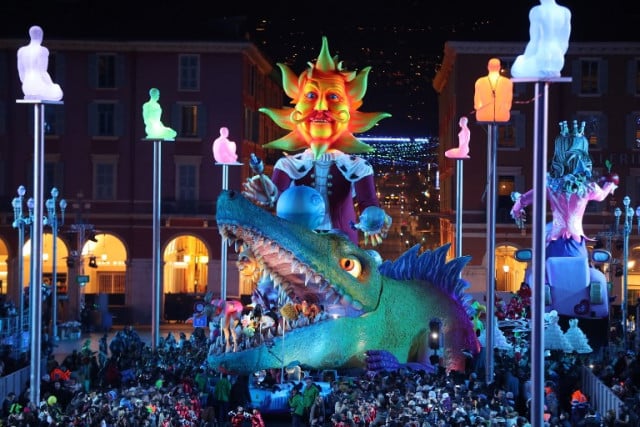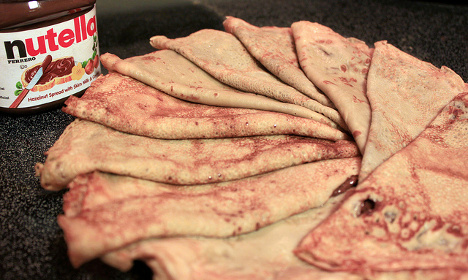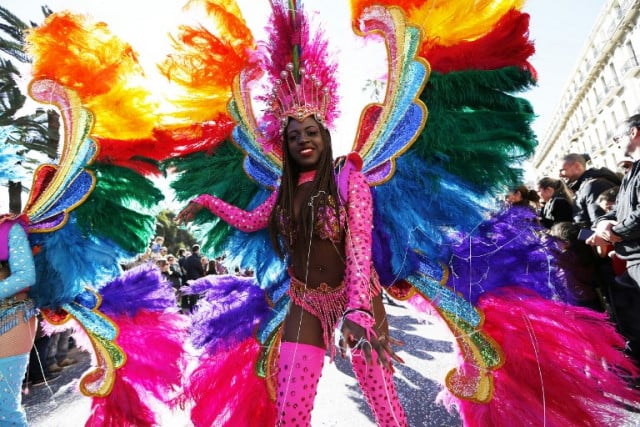CultureFor Members
Carnivals, pancakes and excess: What Mardi Gras means in France

Mardi Gras is upon us and in France that means it's time to eat, dress up and hit the local carnival. Here's what you need to know about how to celebrate 'fat Tuesday' the French way. Here's what you need to know about joining in with the fun of Mardi Gras in France. Where does it come from? The festival, which was adopted by the Christians from a Pagan festival, marks the last day before Lent when people traditionally fast for 40 days and 40 nights. That means Mardi Gras is all about eating and celebrating in excess before the period of moderation and self-denial begins - hence the English translation of Mardi Gras - Fat Tuesday. This year it falls on Tuesday, February 25th.  Nice Carnival. Photo: AFP During Lent, Christians are traditionally supposed to abstain from meat, eggs, as well as sugary and fatty foods. But even if you're not religious, Mardi Gras in France is still used as an excuse to eat some delicious treats and, of course, party. What are the culinary specialties of Mardi Gras? Mardi Gras - known as Shrove Tuesday in Anglophone countries - is also known as Pancake Day. This is because people used to use the opportunity to use up any left over eggs in the cupboard before the start of Lent. However France already has a separate pancake day - the endearingly bonkers festival of La Chandeleur - so although crêpes are eaten on Mardi Gras, there are plenty of other special foods.
Nice Carnival. Photo: AFP During Lent, Christians are traditionally supposed to abstain from meat, eggs, as well as sugary and fatty foods. But even if you're not religious, Mardi Gras in France is still used as an excuse to eat some delicious treats and, of course, party. What are the culinary specialties of Mardi Gras? Mardi Gras - known as Shrove Tuesday in Anglophone countries - is also known as Pancake Day. This is because people used to use the opportunity to use up any left over eggs in the cupboard before the start of Lent. However France already has a separate pancake day - the endearingly bonkers festival of La Chandeleur - so although crêpes are eaten on Mardi Gras, there are plenty of other special foods.  Photo: Jack Zalium/Flickr In the historical south-central region of the Limousin people eat prune pie made with brioche dough. And small donuts are popular around the country. In Lyon they are called bugnes, and in Bordeaux and Provence they're known as merveilles and oreillettes, respectively. They can be made with lemon, orange blossom or vanilla. And some are stuffed with jam or chocolate. Waffles are also a popular sweet treat over Mardi Gras. And what about the carnivals? Carnival is all about letting off some steam. Originally Mardi Gras marked the last day of the festivities and was considered the ultimate day of celebration. Today most French people associate Mardi Gras with wearing disguises or fancy dress, with nearly nine out of ten of them considering it a time for children to dress up and party.
Photo: Jack Zalium/Flickr In the historical south-central region of the Limousin people eat prune pie made with brioche dough. And small donuts are popular around the country. In Lyon they are called bugnes, and in Bordeaux and Provence they're known as merveilles and oreillettes, respectively. They can be made with lemon, orange blossom or vanilla. And some are stuffed with jam or chocolate. Waffles are also a popular sweet treat over Mardi Gras. And what about the carnivals? Carnival is all about letting off some steam. Originally Mardi Gras marked the last day of the festivities and was considered the ultimate day of celebration. Today most French people associate Mardi Gras with wearing disguises or fancy dress, with nearly nine out of ten of them considering it a time for children to dress up and party. Photo: AFP The most famous carnivals in France are in Nice, which is known for its stunning floats, and Dunkerque, where herring are thrown into the crowd. Nice Carnival started on February 15th and runs until February 29th, while in Dunkerque the carnival takes place in the lead up to the festival the carnival starts on Sunday, February 23rd and runs until Mardi Gras itself. Watch out for the flying herring. Where is Mardi Gras celebrated most in France? Mardi Gras is most popular in the north of France, with 40 percent of people in the Hauts-de-France region celebrating the festival. Brittany is just one exception to the rule, where only 18 percent of people celebrate Mardi Gras, according to a recent poll.
Photo: AFP The most famous carnivals in France are in Nice, which is known for its stunning floats, and Dunkerque, where herring are thrown into the crowd. Nice Carnival started on February 15th and runs until February 29th, while in Dunkerque the carnival takes place in the lead up to the festival the carnival starts on Sunday, February 23rd and runs until Mardi Gras itself. Watch out for the flying herring. Where is Mardi Gras celebrated most in France? Mardi Gras is most popular in the north of France, with 40 percent of people in the Hauts-de-France region celebrating the festival. Brittany is just one exception to the rule, where only 18 percent of people celebrate Mardi Gras, according to a recent poll. Comments
See Also
Here's what you need to know about joining in with the fun of Mardi Gras in France.
Where does it come from?
The festival, which was adopted by the Christians from a Pagan festival, marks the last day before Lent when people traditionally fast for 40 days and 40 nights.
That means Mardi Gras is all about eating and celebrating in excess before the period of moderation and self-denial begins - hence the English translation of Mardi Gras - Fat Tuesday.
This year it falls on Tuesday, February 25th.

Nice Carnival. Photo: AFP
During Lent, Christians are traditionally supposed to abstain from meat, eggs, as well as sugary and fatty foods.
But even if you're not religious, Mardi Gras in France is still used as an excuse to eat some delicious treats and, of course, party.
What are the culinary specialties of Mardi Gras?
Mardi Gras - known as Shrove Tuesday in Anglophone countries - is also known as Pancake Day.
This is because people used to use the opportunity to use up any left over eggs in the cupboard before the start of Lent.
However France already has a separate pancake day - the endearingly bonkers festival of La Chandeleur - so although crêpes are eaten on Mardi Gras, there are plenty of other special foods.

Photo: Jack Zalium/Flickr
In the historical south-central region of the Limousin people eat prune pie made with brioche dough.
And small donuts are popular around the country.
In Lyon they are called bugnes, and in Bordeaux and Provence they're known as merveilles and oreillettes, respectively.
They can be made with lemon, orange blossom or vanilla. And some are stuffed with jam or chocolate.
Waffles are also a popular sweet treat over Mardi Gras.
And what about the carnivals?
Carnival is all about letting off some steam.
Originally Mardi Gras marked the last day of the festivities and was considered the ultimate day of celebration.
Today most French people associate Mardi Gras with wearing disguises or fancy dress, with nearly nine out of ten of them considering it a time for children to dress up and party.

Photo: AFP
The most famous carnivals in France are in Nice, which is known for its stunning floats, and Dunkerque, where herring are thrown into the crowd.
Nice Carnival started on February 15th and runs until February 29th, while in Dunkerque the carnival takes place in the lead up to the festival the carnival starts on Sunday, February 23rd and runs until Mardi Gras itself. Watch out for the flying herring.
Where is Mardi Gras celebrated most in France?
Mardi Gras is most popular in the north of France, with 40 percent of people in the Hauts-de-France region celebrating the festival.
Brittany is just one exception to the rule, where only 18 percent of people celebrate Mardi Gras, according to a recent poll.
Join the conversation in our comments section below. Share your own views and experience and if you have a question or suggestion for our journalists then email us at [email protected].
Please keep comments civil, constructive and on topic – and make sure to read our terms of use before getting involved.
Please log in here to leave a comment.